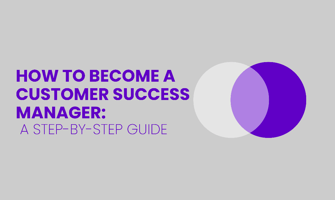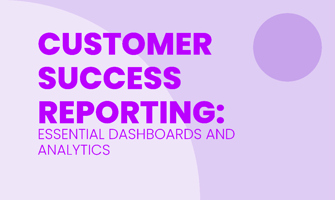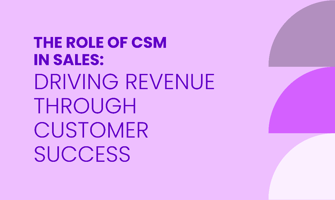Are you interested in a career where you can help others and build lasting relationships? Becoming...
Customer Success Automation: Streamlining Processes for Better Results
Automating customer success can save time and make customers happier.
Smart tools can make onboarding and support more efficient. This means quicker help and happier customers.
Important steps include:
Defining what success looks like
Solving common problems
Making tech systems work together
Monitor things like churn rate and customer satisfaction to see if the automation works well.
Balancing automation with a personal touch is important for great service.
Understanding Customer Success Automation
Customer success automation helps save time and optimize workflows. It automates processes like onboarding, proactive support, renewal management, and customer sentiment monitoring.
For instance, automated emails can make onboarding new accounts smoother. Chatbots and in-app support give instant help, improving the customer experience.
This automation allows team members to focus on solving complex issues instead of routine tasks. Tools like customer success platforms collect customer data, helping team members make informed decisions. These platforms often track CES, CSAT, and product usage for insights into customer health.
Mailmodo helps with email automation. Platforms like Gong assist with outreach and proactive support.
Executives and support leaders can monitor improvement metrics for sustainable growth. Automated workflows can include email templates and chatbots, offering consistent support.
In the end, customer success automation fosters better customer relationships and leads to better experiences and improvement.
Key Benefits of Automating Customer Success
Automating customer success improves efficiency.
It reduces manual workloads for customer success managers (CSMs) through tools like:
Automated emails
Chatbots
Email templates
This allows CSMs to focus on more strategic tasks rather than routine operations.
Automations help provide better and timely customer support. They send proactive support messages and outreach based on customer data.
This leads to increased customer satisfaction (CSAT) and improved customer relationships.
As the customer base grows, automation ensures scalability. It manages larger volumes of accounts without compromising service quality.
Customer success platforms that use automated workflows and insights support continuous improvement and sustainable growth.
Automated processes empower customer success teams with data-driven decisions, ensuring exceptional experiences across the customer journey.
Essential Tools for Support Automation
Support automation tools need to be adaptable, easy to use, and work well with other systems. They should also support multiple communication channels.
Important features include:
Proactive support
Automated emails
Email templates
Chatbots
Integrated CSAT tracking
These tools can connect with customer success platforms like SureTriggers and Planhat. This helps streamline workflows and sync customer data, letting CSMs focus on improvements. Tools like Gong and Mailmodo help improve customer relationships through data and automated outreach.
Efficient onboarding, customer sentiment monitoring, and updates on product usage help improve CSAT. Proactive strategies and effective automation allow CS teams to provide great experiences, leading to growth.
By using insights from operations and service trends, support leaders can empower their teams and enhance the customer journey.
Top Strategies to Automate Customer Success
Automating customer success uses software to handle repetitive tasks. This gives customer success managers more time to build relationships.
Here are some effective strategies:
Use customer satisfaction tools to monitor customer health.
Employ chatbots for proactive support.
Send automated emails and templates from platforms like Mailmodo for onboarding and outreach.
Prioritize automation for high-volume tasks like product usage tracking and creating customer segments.
Machine learning helps analyze customer data from sources like Planhat and Gong. This allows for data-driven decisions that improve workflows for CSMs.
Tools like Salt and SureTriggers offer insights for continuous improvement and sustainable growth.
An enterprise automation platform can integrate various customer success software. It centralizes data from contacts and accounts for better coordination.
Automated solutions let teams focus on high-touch, human interactions. This ensures great experiences and constant improvement throughout the customer journey.
Streamlining the Onboarding Process with Automation
Automating key steps in onboarding can make the process much more efficient.
Here’s how:
1. --Sending Automated Emails and Email Templates--
This can save time and improve communication.
2. --Using Tools like Chatbots--
They offer quick responses and use data to make decisions faster.
3. --Customer Success Platforms--
These tools help track customer health and product usage.
Outreach becomes more targeted and effective.
4. --Leveraging Automation Tools--
Tools such as Suretriggers and Mailmodo allow for personalized onboarding at scale.
5. --Integrating Automation into Operations--
Customer success teams should sync contacts and customer data.
This ensures proactive support.
6. --Insights from Customer Journeys--
Use insights shared by support leaders like Thomas Smeallie and Sonam Dabholkar.
7. --Continuous Improvement--
Platforms like Planhat help CSMs deliver great experiences.
8. --Using Customer Success Software--
Tools like Gong enhance data insights, helping executives make good decisions.
These practices help customer success teams foster growth and build strong, empowered teams. This ensures a smooth transition through effective customer success automation.
Enhancing Proactive Outreach through Automation
By using automation, businesses can find potential customers through customer data analysis and success automation techniques. Tools like customer success software help manage many accounts by tracking product usage and customer health.
Suretriggers and automated emails enable teams to engage contacts quickly. Best practices include using email automation with personalized templates and leveraging chatbots for real-time support.
Customer success platforms, like Planhat, make this easy. Proactive outreach through automation improves retention and satisfaction by making customer service continuous and responsive. Automated workflows handle onboarding, proactive support, and customer relationships efficiently.
Executives can monitor outreach success with metrics like CSAT and CES. This helps support leaders make data-driven decisions for growth and better customer experiences.
Automation strategy ensures great experiences throughout the customer journey. Insights from tools like Gong guide continuous improvement. Balancing automation and the human touch, such as incorporating feedback, helps create engaging interactions.
Leveraging Sentiment Monitoring for Better Customer Satisfaction
Businesses can use sentiment monitoring to find areas needing improvement. They can do this by analyzing customer feedback through CSAT and CES scores.
Tools like Planhat and Gong help track customer health and product usage. Companies can integrate sentiment monitoring into their workflows. This allows for automated outreach through emails and templates from platforms like Mailmodo.
CS teams can have timely and relevant interactions. Real-time insights from chatbots and CSAT feedback help teams provide proactive support and make data-driven decisions.
Executives can use this data to refine their strategies and empower their teams. Automated emails and continuous improvement initiatives help maintain strong customer relationships.
Customer success software and enterprise automation platforms help automate onboarding and operations. This creates a seamless customer journey.
By using these practices, companies can stay updated on customer service trends and drive growth through better customer satisfaction.
Driving Data-Driven Insights with Automated Processes
Automating Data Collection and Analysis
Automating data collection and analysis uses tools like customer success platforms, csms, Gong, and Planhat. These tools help cs teams manage accounts more effectively.
Automated workflows and email tools, such as Mailmodo and automated emails, make the processes smoother. This includes everything from onboarding to proactive support.
With tools like chatbots and Suretriggers, teams get real-time data. This allows csms and support leaders to respond quickly to customer needs.
Automation reduces the manual work in data collection. This lets teams focus on improvement and growth. Executives can use metrics such as CSAT, CES, and customer health to make informed decisions.
Automation strategies improve customer experience and relationships, leading to exceptional experiences. These strategies also support operations by integrating customer data from various sources. This provides a better view of product usage and outreach effectiveness.
Throughout the customer journey, customer success software and automation platforms keep cs teams aligned and effective.
Predictive Analytics for Customer Success
Predictive analytics help customer success (CS) teams identify at-risk customers. They do this by analyzing customer data like product usage and CSAT scores.
For example, customer success software can detect accounts with declining engagement. Data such as the customer effort score (CES) and customer health indicators help build effective models.
Automated outreach and proactive support can be tailored to these insights. Tools like chatbots and automated emails provide timely, personalized communication to ensure customer satisfaction. This automation lets CS managers focus on more complex tasks.
By using data-driven decisions, companies can enhance customer relationships and foster growth. Success automation helps improve experiences, creating confident teams and happy customers. Advanced customer success platforms use insights from tools like Salt and Gong to refine strategies.
Executives, support leaders, and proactive CS managers use these tools to craft personalized journeys. This ensures every contact point, from onboarding to continuous support, is optimized for success.
Balancing automation with a human touch, as advised by experts like Chintan Parekh and Sonam Dabholkar, drives sustainable customer success. Real-time insights from platforms like Planhat and email tools like Mailmodo help align proactive measures with current customer service trends.
Improving Team Collaboration with Workflow Management
Workflow management tools help teams communicate better. They sync tasks, set clear goals, and share updates in real-time.
These systems have useful features:
Automated emails
Chatbots
Email templates
They assist teams like customer success managers and executives in tracking accounts, customer relationships, and product usage.
Using customer success automation helps reduce bottlenecks. It streamlines onboarding and provides proactive support.
Tools like customer success software, customer success platforms, or an enterprise automation platform such as Gong automate workflows for continuous improvement.
Support leaders use automation strategies with CSAT and CES metrics to improve customer experiences through data-driven decisions.
Experts like Sonam Dabholkar, Thomas Smeallie, and Chintan Parekh endorse these practices. They help teams generate better customer service insights.
These methods help customer success teams create great experiences, leading to sustainable growth and improved customer health.
Role of Personalization in Customer Success Automation
Personalization impacts customer success automation by tailoring interactions based on customer data. This makes clients feel valued.
For instance, with tools like CSMs and customer success software, teams create workflows that address specific customer needs. Personalized communications, such as automated emails or chatbots, help with customer retention and satisfaction. They send relevant information during the customer journey.
These tools can provide proactive support based on product usage insights. This ensures customers get the help they need at the right time. Customer data, gathered from accounts, empowers support teams to make data-driven decisions. This data helps create email templates and in-app alerts to guide customers through onboarding and beyond.
Personalized messages enhance the customer experience and encourage growth. By using CES, CSAT, and other metrics, teams can continuously improve their strategies. Executives in large firms might use platforms like Salt or Gong to monitor and adjust their success automation.
The ultimate goal is to offer great experiences that boost customer health and satisfaction.
Best Practices for Continuous Improvement in Customer Success
HubSpot's Approach to Customer Success Automation
![]()
HubSpot uses automation to make customer success processes easier. It handles onboarding, proactive support, and customer health monitoring.
Here are some key tools and methods:
Customer success platform
Automated emails
Email templates for timely outreach and follow-ups
Chatbots and in-app support for real-time data
These tools help Customer Success Managers manage accounts well. Automated emails and chatbots capture real-time customer data. This helps in making smart decisions and improving continuously.
HubSpot's automation ensures proactive engagement. It uses workflows to track product usage and metrics like CSAT and CES. This helps CS teams act quickly and build strong customer relationships.
Support insights and customer service trends help executives understand customer journeys better. Automated outreach and tailored emails enhance customer experience, leading to satisfaction and growth.
By empowering teams and focusing on sustainable operations, HubSpot creates great customer experiences and ensures success through ongoing customer health monitoring.
Salesforce's Automated Customer Success Strategies
![]()
Salesforce uses automated strategies to boost customer success.
Here are some of the tools they use:
Automated emails
Email automation
Chatbots
These tools improve customer satisfaction and relationships.
Customer Success Managers use these automations to:
Track customer health
Monitor customer engagement and product usage
AI and machine learning help CSMs provide proactive support. They also help in making data-driven decisions. This allows CSMs to predict and fix issues early.
Customer success software makes it easy to:
Track outreach
Manage onboarding processes
Executives and support leaders use insights from customer data. This helps them improve the customer journey and provide great experiences.
Tools like Gong help enhance customer service by analyzing customer satisfaction trends.
Other platforms like Planhat, Suretriggers, Salt, and Mailmodo also help in this regard. These tools empower teams for sustainable growth.
By using these strategies, companies see better customer retention and satisfaction. The seamless integration of CSM operations and customer service drives this improvement.
Future Trends in Customer Success Automation
Emerging technologies like AI, machine learning, chatbots, and email automation are shaping customer success automation. AI and machine learning will help customer success platforms make data-driven decisions. This will improve customer effort scores, customer satisfaction, and customer health.
These technologies will let customer success managers and teams focus on building strong customer relationships. Tools like automated emails and templates will support this effort. AI can analyze product usage and customer data to provide insights. This helps teams tailor their outreach and onboarding strategies.
Automation will allow customer success managers to create great experiences. This keeps customer journeys smooth and efficient. Customer success software and automation platforms will help executives plan for ongoing improvement and growth.
Trends show that automation will enable personalized interactions. This empowers support leaders to provide proactive support, making customer experiences more engaging. Tools like Planhat and Gong, along with structured workflows, will help support leaders stay current with customer service trends.
Chatbots and email automation will free up valuable time. This allows customer success managers to handle more complex tasks.
FAQ
What is customer success automation and how does it work?
Customer success automation is the use of tools and technology to streamline processes for managing customer relationships and improving outcomes. It works by automating communication, analysis, and tasks to ensure customers receive prompt support and guidance. Examples include automated email campaigns, proactive customer engagement, and real-time analytics.
What are the benefits of streamlining processes for better customer success?
Streamlining processes can lead to faster response times, improved efficiency, and better customer satisfaction. For example, automating customer support ticketing systems can reduce response times, leading to happier clients and increased loyalty.
How can automation help improve customer retention and satisfaction?
Automation can help improve customer retention and satisfaction by streamlining communication, providing personalized experiences, and offering timely support. For example, using automated email campaigns to send tailored recommendations can keep customers engaged, resulting in increased satisfaction and loyalty.
What are some common challenges faced in implementing customer success automation?
Some common challenges in customer success automation include data cleanliness, integration with existing systems, and gaining buy-in from stakeholders. For example, ensuring accurate and relevant data is crucial for successful automation.
What are some key features to look for in a customer success automation tool?
Some key features to look for in a customer success automation tool include onboarding assistance, proactive outreach, reporting and analytics, and integration capabilities. Examples of such tools include Gainsight, Totango, and ChurnZero.




